What Is Dracena Mahatma?
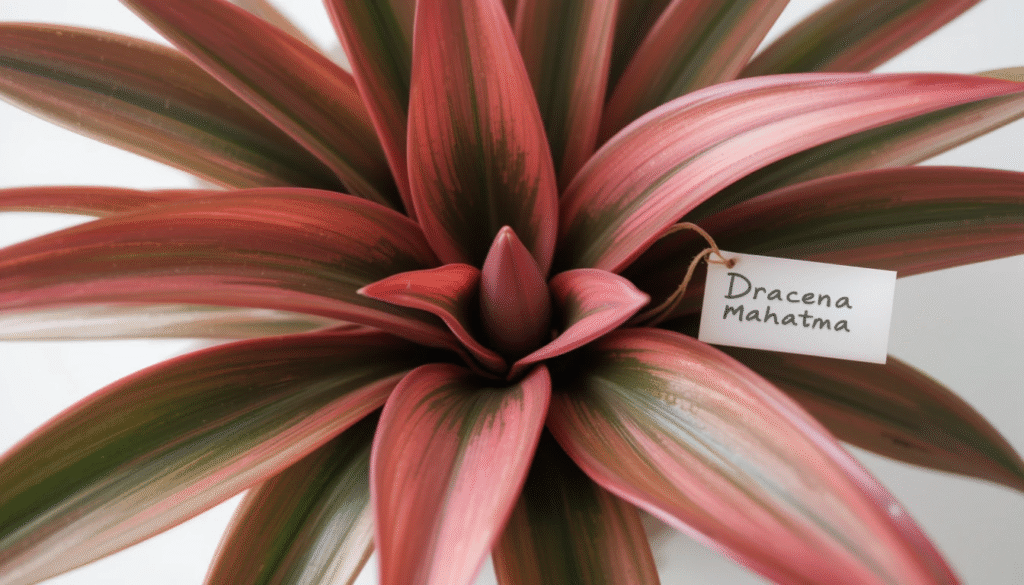
Dracena Mahatma is a beautiful, easy-to-grow indoor plant known for its bright, colorful leaves and low maintenance needs. It’s a favorite among plant lovers who want something stylish, air-purifying, and beginner-friendly. If you’re looking for a houseplant that adds a pop of color to your room without needing constant care, Dracena Mahatma is a great choice.
It’s part of the Dracaena family, a group of tropical plants that are popular for their durability and ability to clean indoor air. Dracena Mahatma stands out for its vibrant mix of green, red, and purple shades, which change as the plant matures.
Scientific Name & Origins
The scientific name of Dracena Mahatma is generally referred to under the Dracaena genus, though “Mahatma” is a cultivar or trade name used mainly in India and Southeast Asia. It’s believed to be a variety of Dracaena marginata or closely related to Dracaena reflexa hybrids, both of which are widely grown as ornamental houseplants.
Dracaena plants are native to Africa, Madagascar, and nearby islands, where they grow in warm, tropical environments. The Mahatma variety is thought to be specially cultivated for its bold color patterns and ease of care.
Why It’s Called “Mahatma”
The name “Mahatma” means “great soul” in Sanskrit, often associated with peacefulness, inner strength, and calmness—qualities that this plant symbolically reflects. Many people believe that Dracena Mahatma brings positive energy, good luck, and harmony to the home, which makes it a popular gift or décor plant in Indian households.
Its graceful, flowing leaves and vibrant colors also give it a majestic appearance, much like the wise and serene image the word “Mahatma” evokes.
Thinking of adding Dracena Mahatma to your indoor garden?
We’d love to help you choose the right plant or guide you through the care process.
👉 Contact us today for expert advice or to place an order!
Key Features & Benefits
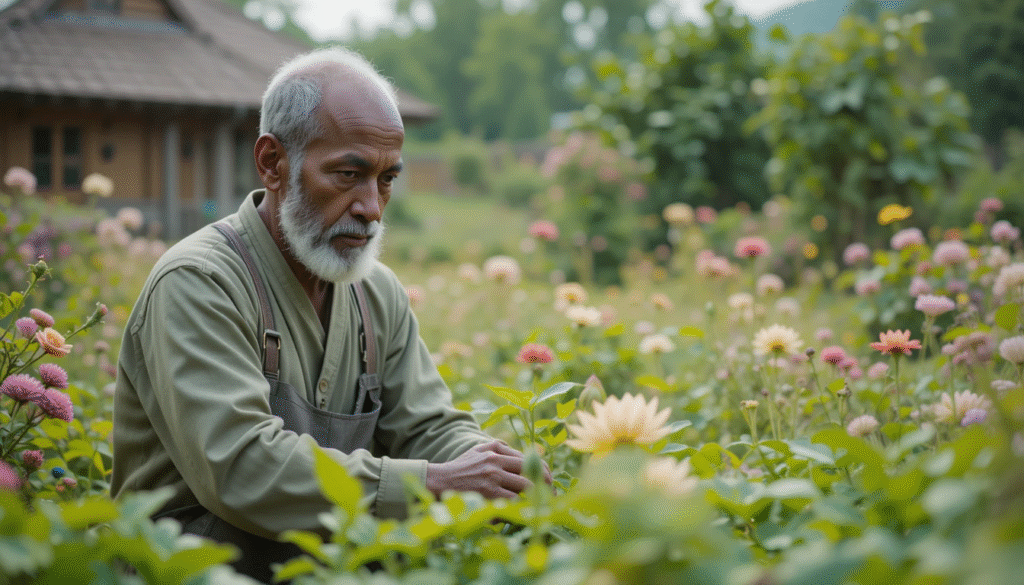
The Dracena Mahatma is more than just a pretty plant. It’s a natural air purifier, a visual delight, and a perfect fit for anyone—from first-time plant parents to seasoned indoor gardeners. Let’s explore the key features that make this plant so special and beneficial for your space.
Stunning Foliage Colors & Patterns
One of the standout qualities of Dracena Mahatma is its vibrant foliage. While most indoor plants come in simple greens, this one offers a splash of bold colors—shades of green, deep purple, red, and pink often swirl together on the same leaf.
Each leaf looks like a brushstroke of nature’s paint. As the plant matures, the colors become even more intense, giving your space a dynamic and ever-changing look. This natural color gradient brings life and personality to any dull corner of your home or office.
The leaf shape itself is also eye-catching—long, pointed, and gracefully arching. In good light, the leaves develop a soft sheen, making them look fresh and glossy year-round. Whether you place it in a decorative ceramic pot or a simple planter, Dracena Mahatma becomes an instant centerpiece.
Why this matters:
- Adds bold style and modern color contrast to your room
- Looks great in minimalist, boho, or tropical décor themes
- Changes appearance slightly through the seasons, keeping it interesting
Natural Air Purifier Properties
Did you know that the air inside your home can sometimes be more polluted than the air outside? Everyday items like paint, cleaning sprays, and even furniture can release invisible toxins called volatile organic compounds (VOCs). That’s where the Dracena Mahatma comes in.
Like other members of the Dracaena family, this plant is known to remove harmful toxins such as:
- Formaldehyde
- Benzene
- Xylene
- Trichloroethylene
These chemicals are commonly found in household products, and breathing them over time can irritate your eyes, lungs, and skin.
According to the famous NASA Clean Air Study, Dracaena plants are among the top air-purifying houseplants, making them excellent for bedrooms, living rooms, or office desks where you spend a lot of time.
Benefits of this natural air purification:
- Creates a healthier indoor environment
- Can help reduce headaches, fatigue, and allergies
- Promotes better sleep and mental clarity
This means you’re not just decorating your space—you’re also making it cleaner and more breathable by simply placing a Dracena Mahatma in the right spot.
Low-Maintenance Plant for Beginners
If you’re someone who forgets to water plants or struggles to keep them alive, don’t worry—Dracena Mahatma is one of the easiest plants to care for. It’s known as a “set it and forget it” plant, which makes it ideal for busy people, students, and even kids learning about plants.
Here’s why it’s beginner-friendly:
1. Tolerates Missed Waterings
Dracena Mahatma prefers the soil to dry out a bit between watering. It’s more tolerant of dry soil than being overwatered. So, if you forget for a few days, it’s usually no big deal.
✅ Water only when the top 1–2 inches of soil feels dry.
2. Does Well in Indoor Light
This plant doesn’t need direct sunlight, which means it can grow happily in a room with filtered light, bright indirect light, or even low-light spots like hallways or corners. Just avoid placing it in total darkness or direct harsh sun, which may scorch the leaves.
✅ Best lighting: Near a window with filtered sunlight or under LED grow lights.
3. Pest-Resistant by Nature
While no plant is completely immune, the Dracena Mahatma is generally not a magnet for pests. If kept clean and in good condition, it rarely suffers from insect problems. Wiping the leaves once a month with a damp cloth helps keep it dust-free and healthy.
✅ Tip: Spray with neem oil once a month for extra protection.
4. No Fancy Fertilizers Needed
You don’t need expensive or complex fertilizers. A basic all-purpose liquid houseplant food, used once every 2 months during growing seasons (spring and summer), is more than enough.
✅ Avoid overfeeding; Dracaenas grow slowly and steadily.
5. Long-Lasting Beauty
With minimal care, your Dracena Mahatma will last for many years. It grows slowly and doesn’t need frequent repotting. This makes it a one-time investment that continues to add value to your space.
✅ Repot only when roots are outgrowing the pot—typically once every 2–3 years.
Summary of Key Benefits
Feature | Why It Matters |
Colorful Leaves | Adds style and brightens interiors |
Air Purification | Cleans the air of toxins for better health |
Easy Care | Perfect for beginners and busy schedules |
Low Light Tolerance | Can grow in most rooms, even with less sunlight |
Non-Demanding | Doesn’t need frequent watering or feeding |
Who Should Grow Dracena Mahatma?
This plant is ideal for:
- First-time plant parents
- People who want cleaner indoor air
- Apartment dwellers with limited sunlight
- Offices, cafés, and wellness centers
- Gift-givers looking for a symbolic, long-lasting present
Its combination of beauty, health benefits, and ease of care makes it one of the most practical and rewarding houseplants to own.
Complete Care Guide
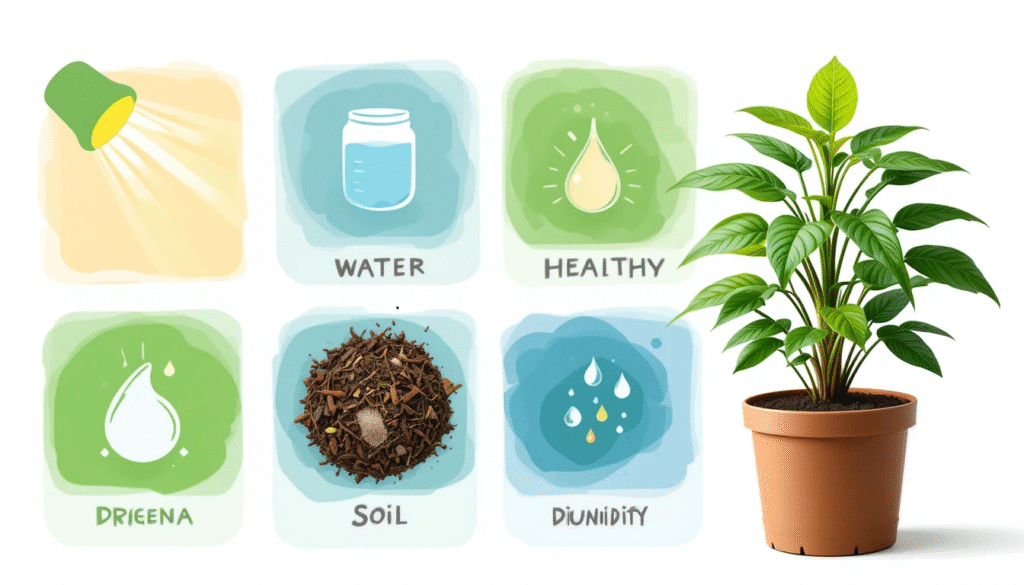
Caring for a Dracena Mahatma is simple, even for beginners. This plant thrives on neglect—seriously! It doesn’t need much watering, prefers soft lighting, and grows steadily in most indoor conditions. If you follow a few basic care steps, your plant will stay healthy, colorful, and vibrant for years.
Let’s break down exactly what this plant needs to grow its best.
Light Requirements (Bright Indirect or Lower Light)
Dracena Mahatma loves bright, indirect sunlight—that means a spot near a window, but not in direct sunbeams. Direct sunlight can burn its colorful leaves and cause brown edges.
If your room gets medium to low light, that’s okay too. This plant adapts well to lower light, although its colors might become slightly less intense. For indoor homes and offices, it’s very forgiving when it comes to lighting.
Best lighting options:
- East-facing window with filtered light
- South or west windows with a sheer curtain
- A bright corner that doesn’t get harsh sunlight
- Artificial LED grow light (especially during winter)
✅ Pro tip: Rotate the plant once a week to keep it growing evenly on all sides.
Watering Tips (Let Top Soil Dry Before Watering)
Overwatering is the #1 reason people accidentally harm their Dracena Mahatma. The plant stores moisture in its thick stems, so it doesn’t need water very often.
Golden rule:
👉 Water only when the top 1–2 inches of soil feel dry to the touch.
How often you water depends on your room’s temperature, humidity, and light:
- In summer: every 7–10 days
- In winter: every 2–3 weeks
Watering tips:
- Use room-temperature water
- Avoid letting the pot sit in water—always empty the saucer
- Water deeply until it starts to drain from the bottom
- Use a pot with drainage holes to prevent root rot
⚠️ Avoid tap water with fluoride or chlorine, which can damage the leaves. Use filtered or boiled (then cooled) water if possible.
Soil & Potting Mix Recommendations
To thrive, Dracena Mahatma needs well-draining, loose soil. It doesn’t like soggy roots, so your potting mix should be airy, not heavy.
Ideal soil mix:
- 1 part regular potting soil
- 1 part cocopeat or peat moss
- 1 part perlite or coarse sand
This mix allows water to drain quickly while keeping just enough moisture to support the roots. If you’re buying pre-mixed soil, choose one labeled “indoor plant mix” or “well-draining potting mix.”
Tips for repotting:
- Repot every 2–3 years or when roots grow out of the pot
- Choose a pot 1–2 inches larger than the current one
- Add fresh mix at the bottom and around the plant
✅ A breathable terracotta pot is a great choice because it helps evaporate excess moisture.
Temperature & Humidity Needs
Dracena Mahatma prefers a warm, humid environment, just like in its tropical homeland. Luckily, it adjusts well to average room conditions in most homes.
Ideal temperature range:
- 18°C to 30°C (65°F to 86°F)
Avoid:
- Cold drafts
- Air conditioners blowing directly on the plant
- Temperatures below 10°C (50°F)—this can damage the leaves
Humidity:
- Likes moderate humidity (40%–60%)
- In dry climates or winter, mist the plant lightly 1–2 times a week
- You can also use a pebble tray with water or place it near a humidifier
✅ Leaf tip browning? That usually means the air is too dry or the water has too many salts. Misting and filtered water help fix this.
Care Summary Table
Factor | What Dracena Mahatma Likes |
Light | Bright, indirect sunlight or partial shade |
Watering | When topsoil is dry; avoid overwatering |
Soil Mix | Well-draining, loose soil with cocopeat/perlite |
Temperature | 18–30°C (room temperature) |
Humidity | Moderate; misting helps in dry conditions |
Pot | Pot with drainage holes, ideally terracotta |
Final Notes
Following this easy care guide ensures your Dracena Mahatma will grow strong, show off its colorful foliage, and stay healthy with very little effort. It’s the kind of plant that rewards you with beauty while asking for very little in return.
Remember:
- Check soil before watering
- Keep it away from cold drafts
- Give it light, but not harsh sun
- Mist the leaves when the air feels dry
With just a little attention, this plant will become a reliable part of your home or office—and you’ll look like a plant expert even if you’re just getting started!
Propagation & Growth Tips
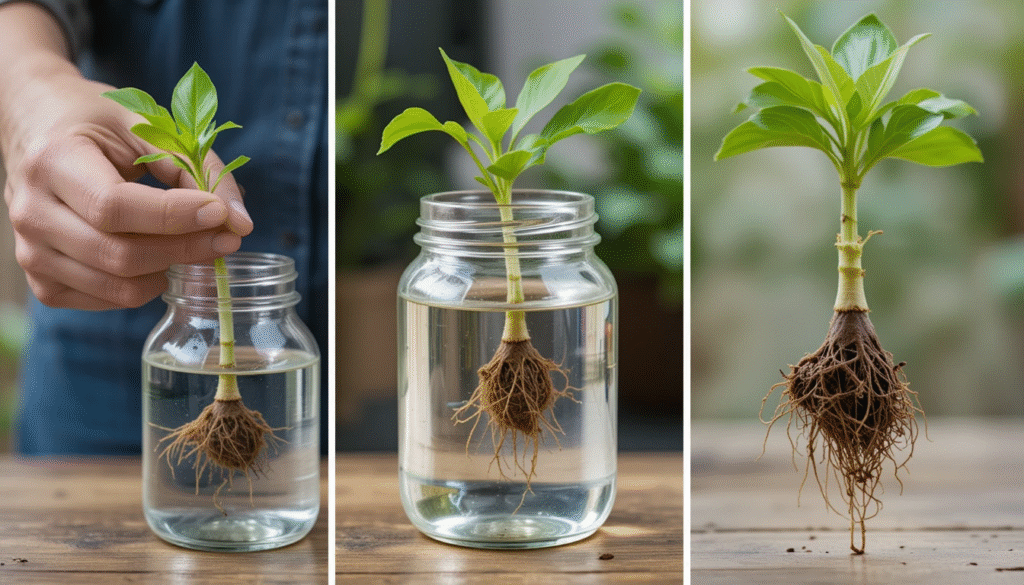
Want more Dracena Mahatma plants without spending extra money? Good news—it’s easy to grow new ones from your existing plant! Propagating this plant is a fun and rewarding way to expand your indoor garden or share it with friends and family.
In this section, you’ll learn how to multiply your Dracena Mahatma using cuttings, the best time to do it, and what signs to watch for to know it’s growing strong.
How to Propagate from Cuttings
The most reliable way to propagate Dracena Mahatma is through stem cuttings. This method works best for upright, cane-like plants such as Dracaena species. It’s quick, simple, and doesn’t require any fancy tools.
Step-by-Step Guide:
- Choose a healthy stem
Select a thick, mature stem that’s at least 6 inches long and has a few leaves on it. It should be free of any pests or damage. - Cut just below a leaf node
Using clean, sharp scissors or pruning shears, cut the stem at a 45° angle just below a leaf node (the part where a leaf connects to the stem). You can take multiple cuttings from a longer stem. - Remove lower leaves
Strip off the bottom 2–3 leaves, leaving only the top few intact. This helps prevent rot and focuses energy on root development. - Optional: Dip in rooting hormone
Not required, but dipping the cut end in a rooting powder or gel can speed up root growth and increase success rate. - Place in water or soil
- Water method: Place the cut end in a glass of clean water and set it in a bright spot (indirect light). Change the water every 3–4 days.
- Soil method: Insert the cutting into moist, well-draining soil and mist lightly. Cover with a plastic bag to trap humidity (optional).
- Wait for roots to form
- In water: Roots should start appearing in 2–3 weeks
- In soil: Gently tug after 3–4 weeks to feel resistance (a sign of new roots)
- Transplant once rooted
Once roots are 1–2 inches long, transfer your baby Dracena Mahatma into a small pot with fresh soil. Water it lightly and treat it like a young plant.
✅ Tip: Don’t panic if older leaves drop off during this process—it’s normal while the plant redirects energy to new roots.
Best Seasonal Timing
Although you can technically propagate year-round indoors, spring and early summer are the best seasons to propagate Dracena Mahatma. This is when the plant is naturally in its active growth phase, which helps cuttings root faster and grow stronger.
Why timing matters:
- Warmer temperatures speed up root development
- Longer daylight hours support new leaf growth
- Higher humidity helps prevent drying out
🌱 Ideal months: March to July
🚫 Avoid: Late fall and winter, when growth slows and success rate drops
Signs of Healthy Growth
So how do you know your Dracena Mahatma is happy and thriving? Here are some clear, positive signs of healthy growth to look out for:
✅ New Leaves Unfurling
If you see new leaves emerging from the center of the stem and slowly opening up—that’s a strong indicator your plant is actively growing. These fresh leaves may look lighter or more vibrant at first.
✅ Strong, Upright Stems
Stems that are firm, upright, and not drooping mean the plant is well-hydrated and structurally strong.
✅ Vibrant Leaf Colors
Dracena Mahatma is known for its dramatic leaf coloring. If the reds, purples, and greens are bold and not fading, your plant is getting enough light and nutrients.
✅ No Leaf Drop
A healthy plant doesn’t shed leaves often. If yours holds onto its leaves without yellowing or drying, it’s likely very happy in its environment.
✅ Steady Size Increase
While Dracaena plants grow slowly, you should notice slight increases in height or new leaves every few weeks during its growing season.
❗Watch out for:
- Brown tips (can signal dry air or salt buildup)
- Yellowing leaves (usually overwatering)
- Mushy stems (possible root rot)
Quick Recap: Propagation & Growth
Task | Summary |
Propagation Method | Stem cuttings (water or soil) |
Best Time to Propagate | Spring to early summer |
Time for Rooting | 2–4 weeks, depending on method |
Healthy Growth Signs | New leaves, vibrant color, upright stem |
Troubleshooting Tips | Adjust watering, humidity, or light |
Final Word
Propagating your Dracena Mahatma is a rewarding way to grow your plant family and understand how nature works up close. With just one parent plant, you can multiply it into several, either to keep or to gift to friends and loved ones.
Even better, watching a tiny cutting grow roots and turn into a thriving new plant is incredibly satisfying—and surprisingly easy. Once you master it, you’ll never have to buy another one again!
Common Issues & Troubleshooting
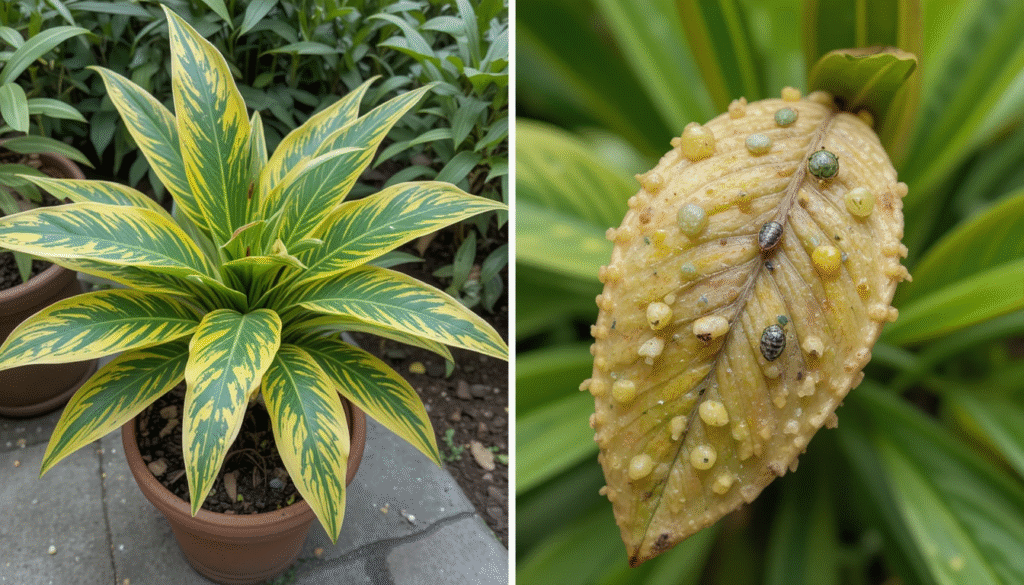
Even though Dracena Mahatma is known for being low-maintenance, it can still run into a few problems—just like any houseplant. The good news is: most issues are easy to fix once you know what to look for.
This section covers the most common plant problems, how to spot them early, and the best ways to solve or prevent them altogether.
Overwatering & Root Rot Prevention
Overwatering is by far the most common issue with Dracena Mahatma. This plant doesn’t like to sit in wet soil for long. If its roots stay soggy, they can start to rot, leading to yellow leaves, mushy stems, and eventually a dead plant.
Signs of Overwatering:
- Yellowing lower leaves
- Mushy, soft stems
- Foul, musty smell from the soil
- Black or brown roots when removed from pot
How to Prevent Root Rot:
✅ Water only when the top 1–2 inches of soil are dry
✅ Use a well-draining soil mix with perlite or sand
✅ Always use a pot with drainage holes
✅ Empty the saucer under the pot after watering
✅ Reduce watering in winter when plant growth slows
🛠 Already have root rot? Remove the plant from the pot, trim off any black/brown mushy roots, let healthy roots air dry for a few hours, and repot in fresh dry soil.
Dealing with Pests (e.g., Spider Mites, Mealybugs)
Dracena Mahatma is fairly pest-resistant, but pests like spider mites and mealybugs can sometimes show up—especially in dry indoor air or if the plant is stressed.
Most Common Pests:
- Spider mites – tiny red or white specks, fine webbing on leaves
- Mealybugs – small white cottony patches in leaf joints
- Scale insects – small, brown bumps stuck to stems or leaves
Natural Pest Control Methods:
- Wipe leaves with neem oil or insecticidal soap
– Mix 1 tsp neem oil, 1 tsp dish soap, and 1 liter water
– Spray or wipe the leaves every 3–5 days until pests disappear - Rinse the plant under lukewarm water
– Do this in a sink or shower to physically remove bugs - Isolate the plant
– Keep it away from other plants while treating to stop the spread
✅ Tip: Keep humidity at moderate levels (40–60%) to discourage spider mites, which thrive in dry air.
Preventing Leaf Discoloration
Leaf color is one of the most stunning features of the Dracena Mahatma—so it can be concerning when those beautiful red, pink, or green shades start to fade or turn brown. Here’s what those changes could mean:
1. Brown Leaf Tips
Usually caused by:
- Dry air
- Fluoride or salt in tap water
- Inconsistent watering
Fix:
– Mist regularly or use a humidifier
– Use filtered or distilled water
– Keep a steady watering routine
2. Yellowing Leaves
Could mean:
- Overwatering
- Poor drainage
- Lack of sunlight
Fix:
– Check the soil moisture
– Ensure the pot has drainage holes
– Move the plant to a brighter spot (but not direct sun)
3. Faded or Pale Leaves
This usually means the plant isn’t getting enough light.
Fix:
– Move it to a brighter area with indirect light
– Rotate the plant weekly for even light exposure
Quick Troubleshooting Table
Problem | Cause | Solution |
Yellowing leaves | Overwatering | Let soil dry out, improve drainage |
Brown tips | Dry air or bad water quality | Increase humidity, use filtered water |
Faded colors | Low light | Move to brighter, indirect light |
Webbing on leaves | Spider mites | Use neem spray or rinse plant |
Cotton-like bugs | Mealybugs | Dab with rubbing alcohol, spray with neem oil |
Mushy roots/stem | Root rot from overwatering | Trim roots, repot in fresh soil |
Final Word
Catching issues early is the key to a healthy Dracena Mahatma. Luckily, this plant is very forgiving—and most problems can be fixed with a few simple changes to its care routine.
Always observe your plant every few days. Leaves, soil, and stems will tell you what the plant needs. And remember: less is more—especially when it comes to watering!
Placement & Decoration Ideas
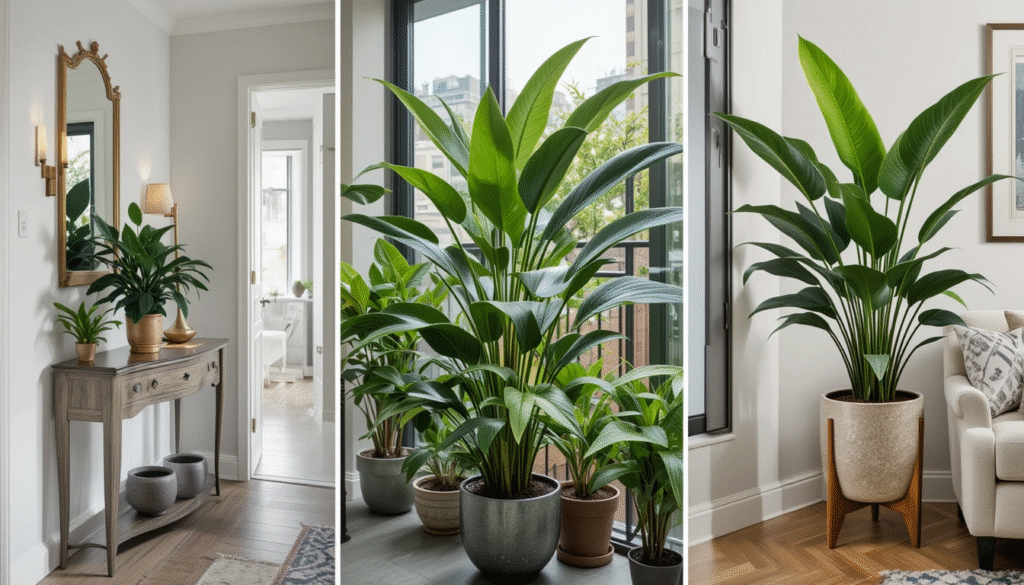
Dracena Mahatma isn’t just easy to grow—it’s also a real showstopper when it comes to home or office decor. With its rich, multicolored foliage and upright growth habit, this plant adds instant personality to any space.
Whether you want to brighten up a dull corner or make a bold design statement, here’s how to style and place your Dracena Mahatma like a pro.
Perfect Spots Indoors (Office, Hallway, Living Room)
Dracena Mahatma thrives best indoors, especially in spots that offer bright, indirect light. But its adaptable nature means you can place it in a wide variety of rooms for both beauty and benefits.
🏢 Office
Place it near your desk or in a corner of your workspace. It not only adds a calming presence but also helps purify the air—great for boosting productivity and mood.
✅ Pro tip: Choose a sleek pot in neutral colors for a modern office vibe.
🏠 Hallway or Entryway
Welcome your guests with a touch of greenery. A tall Dracena Mahatma in a statement planter adds a vibrant focal point and makes even narrow spaces feel alive and warm.
🌿 Narrow hallways? Use a slim, vertical pot to save space.
🛋 Living Room
It’s a natural fit here! Place it:
- Beside the sofa for symmetry
- Near a window with filtered light
- In a plant corner with a few other varieties
💡 Use a plant stand to elevate the Dracena Mahatma and highlight its stunning leaves.
🪟 Balcony or Semi-Shaded Patio
If protected from direct sunlight and harsh winds, it can even live outside in a partially shaded balcony or covered terrace.
Styling Ideas (Groups, Borders, Planters)
You don’t have to be a designer to style your Dracena Mahatma beautifully. Here are some easy, high-impact ways to decorate your space with this plant.
🪴 Grouping with Other Plants
Create a mini indoor jungle! Place your Dracena Mahatma with:
- Snake plant for contrast
- Peace lily for softer foliage
- ZZ plant for height balance
Use varying pot sizes and colors for a layered, natural look.
🟢 Tip: Stick to 3–5 plants per group and mix leaf shapes for visual interest.
🌿 As a Natural Border
Have a long hallway, balcony, or blank wall? Line up 2–3 Dracena Mahatma plants evenly spaced in identical pots. It creates a clean, modern look while softening architectural lines.
🪴 Works especially well with terracotta or matte black planters.
🧺 Decorative Planter Ideas
The pot you choose can totally change the vibe of your space.
- Boho style? Woven baskets or jute planters
- Modern style? Matte black or white ceramic pots
- Rustic charm? Terracotta with natural aging
- Minimalist? Concrete or simple neutral tones
Choose planters that complement your room’s color palette and match the height of surrounding furniture.
Quick Styling Guide
Room/Area | Placement Idea | Recommended Pot Style |
Office | Beside desk or bookshelf | Sleek ceramic or plastic |
Entryway | Near entrance, single tall planter | Decorative, eye-catching |
Living Room | Near window, grouped with other plants | Neutral or textured pot |
Balcony | Semi-shaded corner | Weather-resistant material |
Bedroom | Beside dresser or wardrobe | Soft colors, calming tones |
Final Word
With its bold foliage and easy-care nature, Dracena Mahatma is as much decor as it is a plant. A well-placed plant can transform your space—adding life, color, and peace in one simple step.
Whether you want to brighten up a quiet corner or create an eye-catching indoor garden, this plant is up to the task. All it needs is the right light, a little love, and a beautiful pot to call home.
Why Choose Dracena Mahatma Over Other Dracaenas?
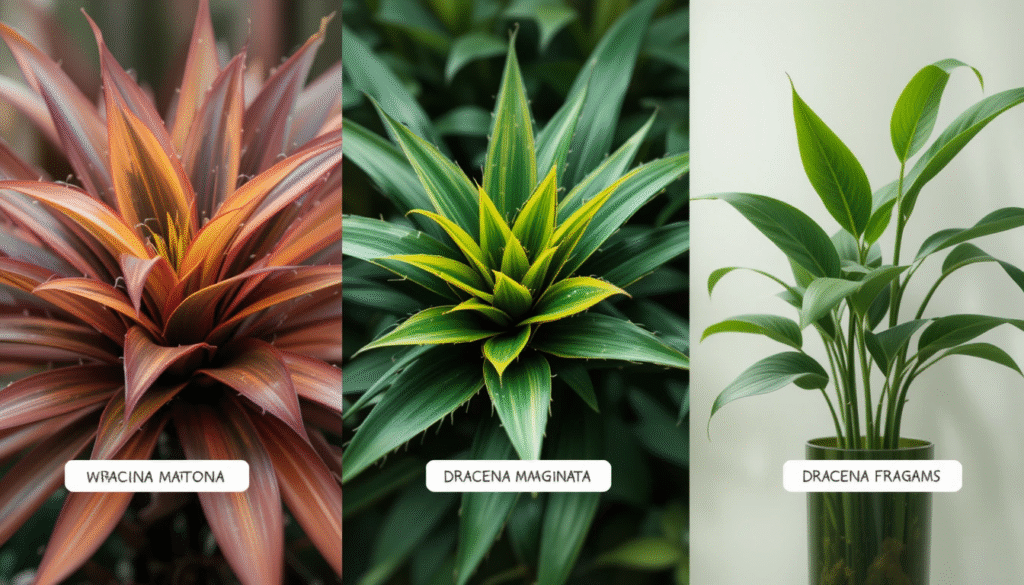
There are many types of Dracaena plants out there—but Dracena Mahatma stands out from the crowd. Whether you’re a beginner looking for a low-fuss plant or a collector hunting for something bold and unusual, this variety brings together beauty, function, and ease in a way few others do.
Let’s compare Dracena Mahatma to other popular Dracaena varieties like Dracaena Marginata and Dracaena Fragrans (Corn Plant) to see why it might be the perfect choice for your home or office.
Air Purification vs. Dracaena Marginata & Fragrans
All Dracaena plants are known for their ability to purify indoor air, but each performs slightly differently depending on leaf structure and surface area.
🪴 Dracena Mahatma
- Broad, colorful leaves with a waxy surface
- Excellent at trapping dust and removing toxins like formaldehyde and benzene
- Works well in medium-sized rooms
🌿 Dracaena Marginata
- Thin, spiky leaves with less surface area
- Still effective, but better suited for smaller spaces
- Requires more time to fill a space visually and functionally
🌽 Dracaena Fragrans
- Larger plant with long, wide leaves
- Great air purifier but takes up more floor space
- Slower to grow and more prone to overwatering
✅ Verdict: Dracena Mahatma offers a perfect balance of air purification and compact size, making it great for apartments and office desks.
Unique Visual Appeal
One of the biggest reasons to choose Dracena Mahatma? It looks nothing like the usual green houseplants. If you’re someone who wants your plant to double as a decor piece, this is where Mahatma shines.
Why It Stands Out:
- Rich, multi-toned foliage in shades of red, pink, and green
- Broad, lance-shaped leaves that catch the light beautifully
- Upright growth that adds structure and elegance to any corner
Compare this to:
- Marginata – Spiky and narrow, mostly green with red edges
- Fragrans – Large green or yellow-green leaves, more traditional look
🌈 Want a pop of color without flowers? Dracena Mahatma is your plant.
Durability & Beginner-Friendliness
If you’re a first-time plant parent or someone who forgets to water regularly, Dracena Mahatma has your back. It’s one of the most forgiving plants in the Dracaena family.
Here’s why it’s so easy to care for:
- Tolerates missed waterings better than Fragrans or Marginata
- Doesn’t need much sunlight—bright indirect light is enough
- Resistant to common pests and diseases
- Rarely sheds leaves unless overwatered
Feature | Dracena Mahatma | Dracaena Marginata | Dracaena Fragrans |
Water tolerance | High (low-maintenance) | Medium | Low (prone to rot) |
Light needs | Medium (indirect) | Medium to high | Medium |
Growth pattern | Upright, bushy | Tall, narrow, spiky | Thick stalk, large leaves |
Aesthetic appeal | Multicolor foliage | Green/red edged leaves | Mostly green |
Suitable for beginners | ✅✅✅ | ✅✅ | ✅ |
🌟 Overall Winner for Style + Ease = Dracena Mahatma
Final Word
If you’re choosing between Dracena varieties, here’s the takeaway:
- Choose Dracena Mahatma if you want color, character, and easy care
- Choose Dracaena Marginata for a more architectural, spiky look
- Choose Dracaena Fragrans if you like big, classic green plants and have space
With its striking appearance, air-purifying benefits, and stress-free care routine, Dracena Mahatma truly deserves a spot on your shelf.
Did You Know? Fun Facts & Cultural Insight

Dracena Mahatma isn’t just another pretty houseplant. It carries a rich background of myth, symbolism, and tropical charm—making it even more special to grow indoors.
Whether you’re a plant nerd or just curious about the story behind your greenery, here are some fun and fascinating facts about the Dracaena family and Mahatma variety.
Historical Uses & Symbolism (“Good Luck”, “Dragon Blood”)
The Dracaena genus—to which Mahatma belongs—has been respected across cultures for centuries. Many species were believed to bring good energy, strength, and even healing.
🌿 Symbol of Good Luck & Prosperity
In Feng Shui, Dracaenas are known to bring:
- Positive energy (Chi) to a room
- Wealth, success, and harmony in homes and offices
- A protective aura that cleanses negative vibes
💡 This is why you’ll often find Dracaenas in entrances, offices, or near money corners.
🔴 “Dragon Blood” Lore
The name Dracaena comes from the Greek word drakaina, meaning female dragon. That’s because a few species, especially Dracaena cinnabari, produce a deep red resin called dragon’s blood.
This resin has been used for:
- Traditional medicine
- Rituals
- Incense and dyes
🌟 While Dracena Mahatma doesn’t produce dragon blood, it carries the mystical legacy of the name.
Tropical Origins & Cultural Significance
Dracena Mahatma, like many in the Dracaena family, traces its roots back to the tropical and subtropical regions of Africa and Asia, including:
- Madagascar
- Southeast Asia
- Parts of Central America
This origin explains why it:
- Loves warm, humid climates
- Thrives in filtered sunlight
- Brings that tropical feel into any indoor space
🌴 In African and Caribbean Traditions:
Dracaenas are used in ceremonies and are often planted near homes to ward off evil spirits and attract blessings.
🧘 In Eastern Cultures:
Dracaena plants are believed to encourage calm energy, making them popular choices for:
- Meditation rooms
- Temples
- Healing gardens
Quick Fun Fact Roundup
🌱 Fun Fact | 🌟 Explanation |
Named after “female dragon” | Because of red resin in related species |
Known as a lucky plant | Popular in Feng Shui for attracting wealth and balance |
Grows in tropical climates | Native to Madagascar, Asia, and parts of Africa |
Used in traditional healing | Dragon’s blood resin was used in medicine and rituals |
Easy to grow indoors | Thanks to its adaptable nature and low water needs |
Final Word
When you bring home a Dracena Mahatma, you’re not just decorating a space—you’re inviting a plant with centuries of cultural significance, good vibes, and natural beauty into your life.
So next time someone compliments your Mahatma, you can smile and say,
“Thanks—it’s not just a plant, it’s a legend.”
FAQs
What is Dracena Mahatma and how is it different from other Dracaena plants?
Dracena Mahatma is a tropical indoor plant known for its vibrant red, pink, and green foliage. Unlike common Dracaena varieties like Marginata or Fragrans, Mahatma offers bolder colors and broader leaves, making it a unique decorative option for homes and offices.
Is Dracena Mahatma a good air purifying plant?
Yes, Dracena Mahatma is an excellent natural air purifier. It helps remove indoor toxins such as formaldehyde, benzene, and toluene, making it ideal for bedrooms, offices, and small spaces where air quality matters.
How do I care for a Dracena Mahatma plant at home?
Dracena Mahatma needs bright, indirect light, well-draining soil, and watering only when the top inch of soil is dry. It thrives in average room humidity and prefers temperatures between 18°C–30°C (65°F–86°F). Avoid overwatering to prevent root rot.
Can I grow Dracena Mahatma from cuttings?
Yes, you can propagate Dracena Mahatma through stem cuttings. Take a healthy cutting with 2–3 nodes, let it dry for a day, then place it in water or moist soil. Roots typically develop within 2–4 weeks during warmer seasons.
Where should I place Dracena Mahatma indoors for the best growth and decor impact?
Place Dracena Mahatma near windows with filtered sunlight, such as in living rooms, hallways, or office corners. It’s great for entryways, group displays with other plants, or as a standalone statement in decorative planters.
